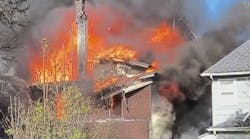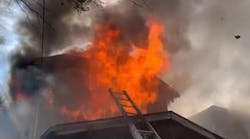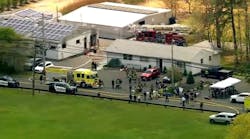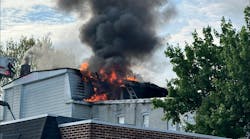In April, we addressed establishing collapse zones at building fires. The loss of situational awareness, coupled with failing to recognize subtle or obvious pre-collapse building indicators and gaps in building/construction system knowledge, increases operational risks to personnel on the fireground. Applying your knowledge of building performance and structuring tactical deployment based on the occupancy risk profile is fundamental to operational excellence and organizational effectiveness.
To conclude our discussion of collapse zones, this month we expand on building construction hazards and recommendations for keeping fire personnel safe on the scene.
Building construction and characteristics
The potential for structural collapse in a building on fire can be predicted by a building’s susceptibility to a variety of factors, including fire dynamics and behavior, fire exposure and extension, environmental impact, fire suppression activities, and building age, deterioration and occupancy use factors. A building’s performance and risk to structural collapse, compromise or failure must be foremost in the minds of incident commanders (ICs), supervisors and operating companies working to develop and execute the incident management plan. Recognizing and defining collapse precursors and risk through exclusion and control zones is fundamental to collapse zone management principles.
Knowledge of a building’s design and structural anatomy, construction methods and materials, and vulnerabilities under fireground conditions has a direct correlation with safe firefighting operations and firefighter survivability. If you understand these factors, you can develop effective tactical plans, manage the fireground and control the building through concise and effective collapse zones and operational exclusion areas.
There are five fundamental building construction relationships that, when aligned, form the Five-Star Command Model. This model prescribes an integrated approach toward knowledge, skills and abilities (KSAs) as well as studies, training, operations and competencies. The core relationships include:
- Building Construction
- Risk Management
- Firefighter Behaviors | Human Performance
- Incident Management | Operations
- Situational Safety
The Building Construction domain has five independent elements:
- Construction Systems
- Occupancies & Risk Profile
- Compromise and Collapse Characteristics
- Materials and Methods of Construction
- Fire Dynamics & Fire Behavior
These five core elements provide a road map that can be applied to any building type construction classification (NFPA 220) or to building type based on vintage (refer to “Reading the Building,” Firehouse Magazine, April 2013).
You may see placards or signage on exterior building areas depicting the presence of engineered structural systems (ESS) or engineered truss construction components for floor (FL) or roof (RF) systems. These placards can provide first-arriving companies with key building information that can help them determine the best tactical interventions.
The building’s structural system, construction and materials will influence the type of structural collapse that’s possible, the scope and severity of the collapse, and the scale of the collapse zones. Building types and occupancies have both common and unique structural collapse profiles that affect the manner in which a perimeter wall, architectural feature or assembly may collapse and the monolithic or segmental extent of the collapse on the fireground.
The occupancy risk of a building of unreinforced masonry (URM) or reinforced masonry (RM) construction must anticipate and expect collapse or compromise to occur during fireground operations. This is especially true when dealing with large-scale or fast-progressing fires in high square-footage buildings, complexes or sets of closely situated structures. The operational probability of a collapse event is likely to be frequent in these building types and should be factored into the development and execution of incident action plans and overall incident management.
Although masonry unit brick and block construction is a prominent collapse risk, the generally accepted horizontal collapse zone (CZ) is considered at 1.5 times the building’s height. In commercial, retail or manufacturing occupancies of Type II construction, perimeter wall systems constructed of single full panels of varying materials, such as precast wall panels, tilt-up concrete assemblies or modularize prefabricated wall panel systems, will fail in a monolithic manner, creating a horizontal collapse zone equal to the full height of the perimeter wall. Personnel must also be consciously aware of the effects of collapsing materials that may travel in excess of the established CZ boundary due to momentum and force.
When established, a CZ should be demarcated in a manner that is apparent, visible and controlled. Barrier ribbon, tape, signage, placards, cones, beacons or other hard barriers can be used to define the CZ and help maintain situational awareness among operating personnel. When it is not feasible or timely to establish hard barriers, the IC must clearly communicate the location and extent of established collapse zones and assign delegated authority for their concise management and control.
- If the fire is not contained and an exterior (defensive) attack becomes necessary, the exclusion zone is moved far enough away from the structure to place the firefighters outside of the collapse zone.
- In large or extended firefighting operations, these zones must be continually adjusted as necessary, and all personnel at the scene must be made aware of the exclusion zone or collapse zone locations.
The IC and assigned divisional supervision must also consider the effect of structural collapse on adjacent or proximal building exposures or structures. Concise communications and physical control of unauthorized access to these buildings and structures is crucial for firefighter safety and survival. Disciplined fireground management at the tactical and task level and self-restraint by company personnel must be achieved and maintained when CZs are established or building exposures themselves are at risk from a primary or secondary structural collapse.
All personnel should be trained to recognize subtle or readily apparent collapse indicators and to be able to read the building and comprehend collapse indicators for primary and secondary collapse conditions. Understanding the mechanism of a building collapse and the causal factors that contribute to the structural collapse provides ICs and company officers with the skills to anticipate and proactively manage the fireground versus responding adversely and in a reactionary manner post-collapse.
Risk assessment matrix
The risk assessment of a building during fire suppression operations must be continuous with building reconnaissance that’s communicated as to degrading conditions, fire extension, building integrity and the effects of fire propagation and suppression on the interior compartment(s), structural system and building envelope.
Commanders should be cognizant of fireground time compression and not rely solely on the passage of time in determining actions necessary to preclude or prepare for structural collapse. The timely formation of collapse zones for both primary and secondary collapse must be a principal fireground consideration when collapse indicators are identified.
Collapse considerations
Following are several collapse considerations that fire personnel must take into account to make effective decisions regarding collapse zones:
- Building type and characteristics
- Building structural anatomy
- Construction systems and type
- Methods and materials
- Occupancy risk profile
- Building vintage, age and condition of use
- Identification of inherent collapse attributes
- Predictability of building performance (building size, volume and distribution, building age and physical condition, degree of compartmentation, fire load package and probability of extension, floor system characteristics, etc.)
- Degree of alteration, renovation or modification
- Presence and operability of fixed suppression systems
- Presence of ornate architectural features or components
- Freestanding building components, treatments or attachments
- Presence of parapets or other roof edge assemblies
- Presence of large overhangs, canopies, awnings or expansive facades or coverings
- Evidence of building damage, compromise or effects from environmental exposure
- Fire intensity, severity, magnitude and location
- Adequacy of sustainable water supply and delivery system
- Fuel loading and potential for significant heat release rates/effects on fire suppression
- Adequacy of staffing and resources
- Operational capabilities or limitations of the organization or companies
Key controls
Following are ways fire personnel can help control collapse hazards, both before and during incidents:
- ICs and company officers should develop skill sets in building construction, collapse indicators and building profiling to support fireground observations and decision-making.
- They should also develop and implement fireground risk assessment considerations for structural collapse and protocols for establishing and managing collapse zone and exclusion areas.
- Fire personnel should identify and implement alternative adaptive tactical procedures or protocols for buildings in their jurisdiction that have inherent structural collapse characteristics and may be prone to collapse or comprise during fireground operations.
- The recognition and timely formation of effective collapse zones for both primary and secondary collapse must be a principal strategic fireground consideration when suspected or apparent collapse indicators are identified and assessed. Anticipate, expect and implement controls proactively.
- All personnel should be trained to recognize subtle or readily apparent collapse indicators and be able to read the building and comprehend collapse considerations for primary and secondary collapse conditions for buildings in the jurisdiction.
- Personnel should design and implement a placarding system to identify high-risk and high-frequency collapse prone buildings to support timely size-up and IAP development for initial-arriving companies.
- The IC should establish and manage a collapse zone early in an incident to preclude time delays and reactionary measures that place personnel in risk-prone settings.
- In buildings of Type III ordinary (URM or RM) or Type IV heavy timber construction, including mill and semi-mill construction, incident command must be highly focused on the high probability of internal and external collapse, establish and control collapse zones in multiple divisions and possible exposure properties, and expect collapse to occur.
NIOSH also provides a list of precautions and actions to minimize hazards and risks to firefighters due to structural collapse during fireground operations. The lists—which cover pre-, during and post-incident—can be found here: www.cdc.gov/niosh/docs/wp-solutions/2014-120/pdfs/2014-120.pdf.
Final considerations
Without understanding the building-occupancy relationships and integrating building construction sciences, occupancy risk profiling, fire dynamics/behavior, dynamic risk analysis coupled with a well-informed IC, company-level supervision and task-level competencies, you are negligent in your duties—and not everyone may be going home. Begin your quest for knowledge to do your job as a firefighter or officer more effectively for operational excellence.
Maintaining heightened situational awareness on the operating scene, knowing what to look for and comprehending what it is you are seeing relative to collapse indicators or risk are key attributes for preventing firefighter death and injury.






